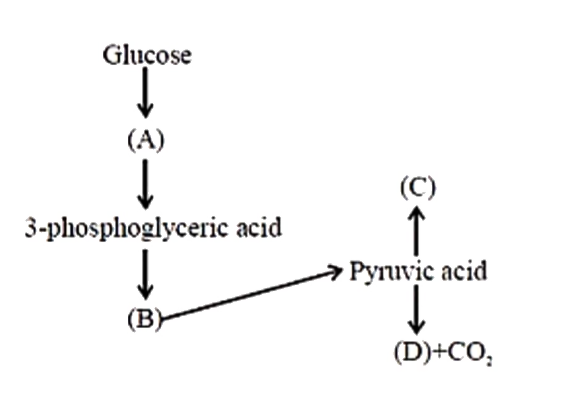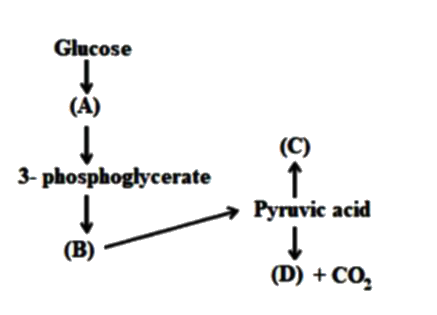Choose the correct match from the following
A. Constricted fruit
M. Cucumber
B. Cartilaginous endocarp
N. Apple
C. Epicarp with oil glands
O. Acacia
D. Rind like epicarp
P. Citrus
A-O, B-N, C-M, D-P
A-O, B-N, C-P, D-
A-P, B-N, C-O, D-N
A-N, B-O, C-P, D-M
The correct Answer is:B
To solve the question of matching the fruit features with their corresponding fruits, we can follow these steps:
Step 1: Analyze the Features
We need to understand what each feature in column A refers to:
- A. Constricted fruit: This typically refers to fruits that have a narrow or pinched appearance.
- B. Cartilaginous endocarp: This refers to a type of endocarp that is flexible and somewhat pliable.
- C. Epicarp with oil glands: This indicates the outer layer of the fruit has oil glands, which can release juices.
- D. Rind-like epicarp: This describes a thick, hard outer layer of the fruit.
Step 2: Analyze the Fruits
Next, we need to understand what each fruit in column B is:
- M. Cucumber
- N. Apple
- O. Acacia
- P. Citrus
Step 3: Match the Features with the Fruits
Now, we will match the features with the fruits based on our understanding:
- A. Constricted fruit: This matches with O. Acacia. (Acacia pods can be constricted.)
- B. Cartilaginous endocarp: This matches with N. Apple. (Apples have a flexible endocarp.)
- C. Epicarp with oil glands: This matches with P. Citrus. (Citrus fruits like oranges and lemons have oil glands in their peels.)
- D. Rind-like epicarp: This matches with M. Cucumber. (Cucumbers have a thick, rind-like outer layer.)
Step 4: Finalize the Matches
Now we can summarize our matches:
- A - O (Constricted fruit - Acacia)
- B - N (Cartilaginous endocarp - Apple)
- C - P (Epicarp with oil glands - Citrus)
- D - M (Rind-like epicarp - Cucumber)
Conclusion
The correct matches are:
- A - O
- B - N
- C - P
- D - M
We need to understand what each feature in column A refers to:
- A. Constricted fruit: This typically refers to fruits that have a narrow or pinched appearance.
- B. Cartilaginous endocarp: This refers to a type of endocarp that is flexible and somewhat pliable.
- C. Epicarp with oil glands: This indicates the outer layer of the fruit has oil glands, which can release juices.
- D. Rind-like epicarp: This describes a thick, hard outer layer of the fruit.
Next, we need to understand what each fruit in column B is:
- M. Cucumber
- N. Apple
- O. Acacia
- P. Citrus
Now, we will match the features with the fruits based on our understanding:
- A. Constricted fruit: This matches with O. Acacia. (Acacia pods can be constricted.)
- B. Cartilaginous endocarp: This matches with N. Apple. (Apples have a flexible endocarp.)
- C. Epicarp with oil glands: This matches with P. Citrus. (Citrus fruits like oranges and lemons have oil glands in their peels.)
- D. Rind-like epicarp: This matches with M. Cucumber. (Cucumbers have a thick, rind-like outer layer.)
Now we can summarize our matches:
- A - O (Constricted fruit - Acacia)
- B - N (Cartilaginous endocarp - Apple)
- C - P (Epicarp with oil glands - Citrus)
- D - M (Rind-like epicarp - Cucumber)
The correct matches are:
- A - O
- B - N
- C - P
- D - M
Similar Questions
Based on the given process, identify the correct match for A,B,C and D from the following options.
 View Solution
View SolutionIn fig. 28.7 if the coordinates of point P are (a,b,c) then Write the coordinates of points A, B, C, D, E and F. Write the coordinates of the feet of the perpendiculars from the point P to the coordinate axes. Write the coordinates of the feet of the perpendicular from the point P on the coordinate planes XY, YZ and ZX. Find the perpendicular distances of point P from XY,YZ and ZX− planes. Find the perpendicular distances of the point P fro the coordinate axes. Find the coordinates of the reflection of P are (a,b,c) . Therefore OA=a, OB=b nd OC=⋅
View Solution
Knowledge Check
- Question 1 - Select One
Based on the given process, identify the correct match for A, B, C and D from the following options.
 AABCDPGALPEPC2H5OHLactic acidBABCDPGALPEPLactic acidC2H5OHCABCDG-6-P2−PGAC2H5OHLactic acidDABCDPEPF-6-PLactic acidC2H5OH
AABCDPGALPEPC2H5OHLactic acidBABCDPGALPEPLactic acidC2H5OHCABCDG-6-P2−PGAC2H5OHLactic acidDABCDPEPF-6-PLactic acidC2H5OH - Question 2 - Select One
Which of the following is / are correct ?
I in dry fruits the pericarp is dry and is not differentiated into epicarp mesocarp and endocarp
II in succulent fruits the pericarp is fleshy and is differentiated into epicarp mesocarp and endocarp
III capsular fruits are those simple dry multi seeded after ripening and seeds are exposed
IV achenial fruits are multiseeded dehiscent in which pericarp ruptures and seeds remain inside
Choose the correct optionAonly IVBI II and IIICAll the theseDnone of these - Question 3 - Select One
Choose the correct alternative (more than one may be correcT) (B.M.C=Bimolecular collision) (at constant P) (n is constant throughout).
Aλ is constant.BBMC made by 1 molecule per second is directly proportional to T.CBMC for all the molecuels per unit volume is directly proportional to T2Dnone of these
Choose the correct order of the property given below
(A) N3−<O2 ; ionic radius "
(B) "N>O" ; first ionization energy
(C) N < O; second ionization energy
(D) "N>O" ; electron affinity orderView SolutionAmong M, N, O, P and Q, (i) N is taller than only P and (ii) O is the 2nd tallest person. To decide the tallest among them, the data in which of the following statements is (are) sufficient ?
(A) M is taller than N
(B) M, though taller than N, is not as tall as Q
(C) Q is taller than N
(D) O is taller than both M and N
1) Only (D)
2) Either (B) alone or (D) alone
3) Only (B) or only (A) and (C) together
4) (B) and (D) together
5) None of theseView SolutionWhich of the following is not related with Guava?
A. Floral organs like Sepals, Petals and Stamens are present at the margin of thalamus
B. Fruit has stony endocarp
C. Position of other floral organs with respect to ovary is inferior
D. Thalamus incompletely covers the ovaryView SolutionM is the son of N. O is the father of N. P is the father of M. How is N related to P?
View SolutionWhich of the following is not related to Guava ?
A. Floral organs like Sepals, Petals and Stamens are present at the margin of thalamus
B. Fruit has stony endocarp
C. Position of other floral organs with respect to ovary is inferior
D. Thalamus incompletely covers the ovaryView Solution

